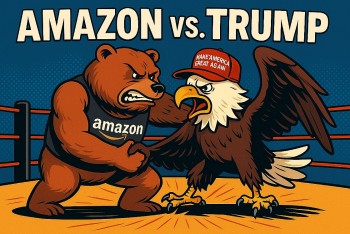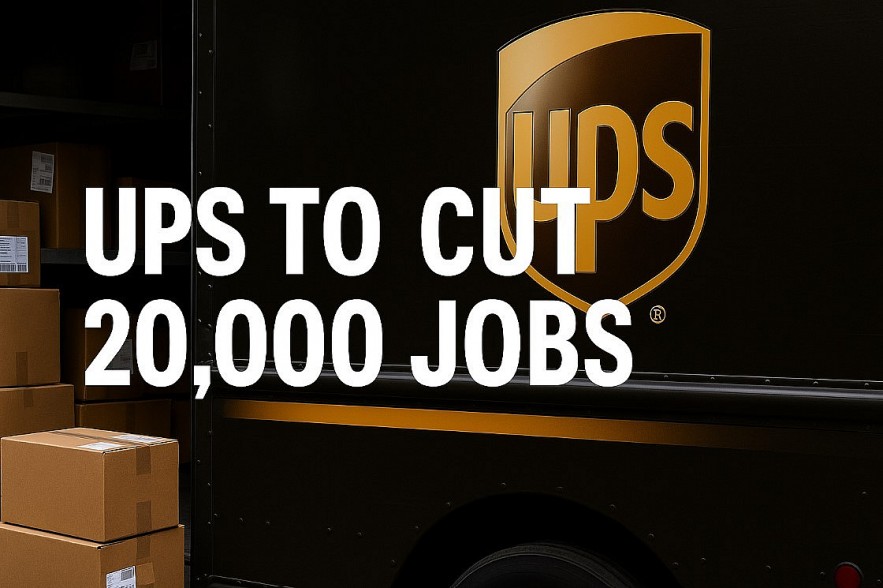UPS to Cut 20,000 Jobs: Inside the Strategic Shakeup and What's Next
 Wall Street Tumbles After Trump Tariffs Shock Markets: Apple, Tesla, Amazon Among Hardest Hit Wall Street Tumbles After Trump Tariffs Shock Markets: Apple, Tesla, Amazon Among Hardest Hit |
 Amazon vs. Trump: Tariffs, And Politics Amazon vs. Trump: Tariffs, And Politics |
 |
| UPS cutting 20,000 jobs amid reduction in Amazon shipments |
Strategic Retrenchment: Profit Over Volume
In a bold move reshaping the logistics landscape, UPS announced on Tuesday that it plans to cut 20,000 jobs in 2024. This decision, impacting more than 4% of its 490,000-strong workforce, is closely tied to the company's deliberate reduction of its reliance on Amazon — once its largest customer.
UPS, which operates in over 200 countries, is moving away from chasing sheer delivery volume. CFO Brian Dykes emphasized that the company's goal is to sharpen its U.S. domestic margins and profitability, targeting $3.5 billion in savings this year.
"These actions will enable us to expand our U.S. Domestic operating margin and increase profitability," Dykes said during the earnings call.
The layoffs are driven by several key factors: decreasing delivery volume from Amazon, the need to consolidate facilities to reduce operational costs, and external economic uncertainties including trade tensions.
As part of the overhaul, UPS will close 73 buildings by mid-2025 and is considering further closures. These steps follow last year’s elimination of 12,000 positions, signaling a deeper transformation rather than temporary belt-tightening.
The Amazon Disconnect: A Strategic Divorce
The relationship between UPS and Amazon is changing dramatically. Although Amazon had offered to increase volumes, UPS chose to scale back instead, seeking to prioritize high-margin shipments over bulk deliveries.
"Due to their operational needs, UPS requested a reduction in volume and we certainly respect their decision," Amazon spokesperson Kelly Nantel said.
By cutting Amazon volumes by more than 50% starting in late 2026, UPS is gambling that higher revenue per package will outweigh the loss in sheer volume. However, with Amazon aggressively building its own delivery network, this move risks ceding market share over time.
Union on High Alert: Labor Battles Brewing
The Teamsters Union, representing around 330,000 UPS workers, has signaled it will not tolerate any encroachment on union jobs. Under the current national master agreement, UPS must create 30,000 new Teamsters positions.
"If UPS wants to downsize corporate management, the Teamsters won't stand in its way," said Sean M. O'Brien, Teamsters General President. "But if the company tries to cut union jobs, UPS will be in for a hell of a fight."
Labor tensions could escalate quickly if the cuts move beyond corporate roles, posing a real threat of strikes or other disruptive actions.
Trade Risks and Global Headwinds
Externally, UPS faces rising risks from shifting global trade policies. With 400,000 imported parcels daily — about 2% of its overall package volume — any escalation in U.S.-China tensions could squeeze margins.
CEO Carol Tomé noted that China-to-U.S. shipments represent 11% of UPS’s international revenue, and remain the company's most profitable trade lane.
To mitigate these risks, UPS is providing customers with tariff information through its "Global Checkout" tool. But turbulence from global trade wars could still create financial and operational headaches.
Stock Market Reaction and Industry Impact
Investors showed cautious skepticism; UPS shares fell by 0.6% to $96.61 following the news. Analysts warn that while the strategic pivot could eventually strengthen UPS, the immediate aftermath could involve customer churn, internal strife, and partner instability.
Meanwhile, Amazon continues to innovate in logistics, posing a growing competitive threat. Its plans to diversify carrier partnerships and bolster its delivery infrastructure mean UPS must execute flawlessly to maintain relevance.
The Road Ahead: High Stakes for UPS
UPS’s sweeping changes mark a pivotal moment. The company is betting on a leaner, more profitable future rather than sheer scale. But the risks are enormous: labor disputes, customer defections, trade barriers, and intensifying competition.
How UPS manages these challenges will determine whether it cements its leadership in logistics or finds itself sidelined by bolder, more adaptable rivals.
FAQs
Why is UPS cutting 20,000 jobs?
UPS is cutting jobs to consolidate operations, boost profitability, respond to reduced shipment volumes from Amazon, and adjust to global economic pressures, including trade uncertainties.
How will the layoffs impact UPS employees?
Layoffs will mainly target corporate and operational roles, though unionized positions are protected under the Teamsters' national agreement. Negotiations and potential disputes could arise if union jobs are affected.
What happens to UPS's relationship with Amazon?
UPS and Amazon will continue working together, but volumes will decrease significantly. UPS chose to prioritize more profitable deliveries, while Amazon continues building its own delivery network.
Will trade tensions affect UPS's business?
Yes, particularly shipments from China, which account for 11% of UPS’s international revenue. Tariff increases or trade restrictions could hurt UPS’s most profitable trade lanes.
Is UPS still a good investment?
The long-term outlook depends on how successfully UPS navigates cost-cutting, maintains service quality, manages labor relations, and adapts to global trade shifts.























